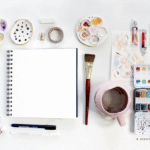Creating your own craft room sounds like a dream come true for many creative people, but it can also feel like an expensive project. The good news is, you don’t need to break the bank to build a functional, inspiring space. Whether you enjoy sewing, painting, paper crafts, or DIY projects, you can set up a great craft room even on a tight budget.
In this guide, you’ll learn how to turn any small space into a budget-friendly crafting corner using smart planning, repurposed materials, and creative organization.
Start With What You Have
Before you buy anything, take a look around your home. You might already have furniture or storage items you can use. An old desk, kitchen shelf, foldable table, or even sturdy boxes can serve as a foundation for your craft setup. Many people are surprised to find they don’t need to purchase big-ticket items once they take inventory.
Use what you already own creatively. An unused bookshelf can store supplies. An old dining chair can become your craft chair. A simple wall hook can hold tools or scissors. Repurposing is key when working with a small budget.
Choose a Dedicated Space
You don’t need an entire room to craft. A small corner in your bedroom, a part of the dining room, or even a closet can work beautifully. The goal is to have a spot where your tools and materials are organized and easy to reach.
Choose a space with good lighting and easy access to power outlets if you use tools like glue guns or sewing machines. If possible, pick a quiet corner so you can focus and enjoy your creative time without interruptions.
Keep the Furniture Simple and Affordable
Skip fancy or custom furniture. Instead, go for budget-friendly options like:
Foldable tables from discount stores or online marketplaces
Used or thrifted desks or tables
Bookshelves from yard sales
Plastic storage carts
Stackable bins and drawers
You can often find these secondhand or at low-cost retailers. Check local Facebook Marketplace, thrift stores, and garage sales for hidden treasures. A little cleaning or paint can make an old item look brand new.
Smart Storage Solutions
Organizing your supplies doesn’t have to be expensive. Here are some clever and budget-friendly storage ideas:
Use glass jars, mason jars, or recycled food containers to store buttons, beads, or threads
Hang a pegboard or corkboard for scissors, tape, and ribbon rolls
Use cardboard boxes or shoe boxes for paper, fabric, and magazines
Label everything to make your items easier to find
Try over-the-door organizers for additional vertical storage
Even a set of clear plastic drawers can go a long way in keeping your space neat and manageable. The key is visibility and access—when you can see what you have, you’re more likely to use it.
Create a DIY Work Table
If you can’t afford a new worktable, make one yourself. Stack two small bookshelves or crates and place a sturdy wooden board or tabletop across them. Not only do you get a table, but the shelves can hold your supplies too.
For extra savings, visit home improvement stores for discounted or scrap wood pieces. Many stores are happy to cut them to size for free or a small fee.
Make Use of the Walls
Wall space is often overlooked, but it’s incredibly useful for craft rooms. Mount shelves to store materials, or install wall racks and baskets to keep supplies within reach. You can even hang up a magnetic strip to hold metal tools like scissors or rulers.
If you’re renting or can’t drill holes, try adhesive hooks, over-the-door racks, or tension rods. Wall storage frees up desk space and keeps everything easy to grab while working.
Add Creative Touches on a Budget
Just because you’re spending less doesn’t mean your craft space can’t be beautiful. Decorate it with things you already own or make yourself:
Frame your own artwork or quotes
Create a vision board with magazine cutouts
Use colorful bins or baskets from the dollar store
Add string lights or a cute desk lamp for cozy vibes
Use washi tape to decorate your desk or shelves
A well-decorated craft corner inspires creativity and makes you want to spend time there.
Organize By Project or Category
Sorting supplies by project type or category will make your craft time more efficient. Keep paper supplies together, group your painting tools, store sewing items in one bin, and so on. This reduces clutter and saves you time searching for items.
You can even use color coding or printed labels to easily identify each section.
Don’t Buy Everything at Once
It’s tempting to stock up on all the beautiful craft supplies and storage containers, but pace yourself. Start with the essentials. Buy tools and materials based on the type of crafting you do most often.
Add to your setup slowly as your needs grow. You’ll make better decisions when you know what works for you and what you actually use.
Invite Creativity, Not Clutter
A great craft space doesn’t need to be packed with items. The most productive creative spaces are often simple and tidy. Leave room to move, breathe, and think. Your goal is a workspace that helps you feel calm and inspired.
Final Thoughts
Setting up a craft room on a small budget is completely doable. With a little creativity, planning, and resourcefulness, you can build a space that reflects your personality and supports your passion. You don’t need fancy furniture or expensive organizers to get started. Just focus on making a space that feels like your own.
So grab what you already have, look for budget deals, and start turning that empty corner into a crafting haven. Your dream craft room is closer—and cheaper—than you think.
Frequently Asked Questions (FAQs)
1. What’s the most important thing to have in a craft room?
A sturdy work surface and organized storage are the two most essential elements. Everything else can be added gradually.
2. How much space do I need for a small craft room?
Even a 3×4 foot corner can be enough. The key is organization, not size.
3. Where can I find cheap craft supplies and furniture?
Check local thrift stores, dollar stores, garage sales, Facebook Marketplace, and clearance sections of craft or home stores.
4. How do I organize a lot of small crafting tools?
Use labeled containers, small drawer sets, or divided trays. Mason jars and muffin tins are also great for sorting tiny items.
5. Can I have a craft room in a shared space?
Yes, just designate a specific area like a corner of your living room or bedroom and use portable storage so you can tuck things away when not in use.







